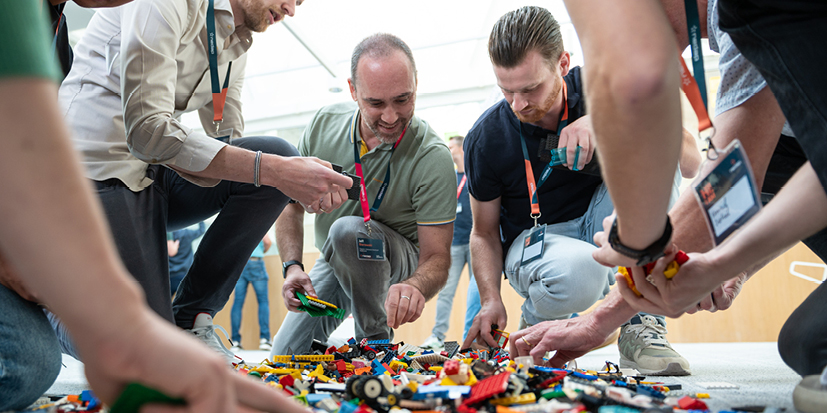1.4 Our strategy
As part of the Step Up! strategy, our strategic principles are written down in the Nedap Story. A new key element in our story was making the pursuit of market leadership one of our strategic guiding principles. Analysis of our proposition portfolio confirmed its excellent growth potential. However, it was also clear that structural acceleration of our growth was necessary to become a market leader in the markets we operate in.
Our organisational structure at the time, based on autonomous business units with decision-making freedom in various business aspects, fostered entrepreneurship and market focus, resulting in a diverse and innovative portfolio. However, the fragmentation of knowledge and capabilities within Nedap across the units hindered the full realisation of our propositions’ growth potential. This insight led to one of the objectives of Step Up!: to find an improved way of working within Nedap. One that embraces market focus and entrepreneurial spirit, while leveraging the collective strength of the entire Nedap organisation.
Our new way of working with the strategic drivers radically clear, always deliver and full Nedap power as articulated at the start of Step Up!, is proven to be very useful in steering and inspiring initiatives. This gives us confidence that we are developing a method that facilitates both projects or activities requiring execution from a Nedap perspective and those necessitating razor focus to succeed in a market.
Radically clear
The core of the first strategic driver, radically clear, is that we have to be clear in our assumptions, decisions, ambitions and goals. If these are explicit and unambiguous, it becomes easier to share them with colleagues, thus ensuring that everyone across the company is aware of the strategic direction of Nedap, the business units and the teams, and of what is expected of everyone. On top of that, clear plans and actions enable us to reflect on the impact of our choices and steepen our learning curve as a company, empowering us to stay ahead of the competition.
Always deliver
The second strategic driver that is part of our new way of working is always deliver. We commit to plans and key milestones. In order to be able to carry out plans and reach milestones, we need to be aware of each other’s expectations and keep the promises and agreements we make.
Full Nedap power
Full Nedap power is the third strategic driver. The collective knowledge, talent, experience and capacities must be accessible to all. By making the most of our organisation’s collective strength, we aim to unlock the full Nedap power.
Create-Scale-Core model
To facilitate better strategic decision-making, we have made various aspects of our strategic approach explicit. This makes it easier to share our perspective on strategy development and implementation more broadly within our company. A key element in this is the Create-Scale-Core model (CSC). This model fosters sharper strategic discussions about the development, choices, and decisions regarding our propositions.
Create
In the Create phase, the main objective is to validate a proposition’s market potential and assess whether it gives us the required level of competitive differentiation. The main challenge in this phase is for a small team to engage with the right customers to quickly gauge their response to the proposition and not to hesitate to go back to the drawing board when there is insufficient response from the market. This phase will ultimately result in a validated proposition and a scalable business model with the first paying customers, and that is ready to be scaled up.
Scale
The central objective during the Scale phase is to gain the largest possible market share with a proposition. This is when the focus shifts from concept development and business development to sales, marketing and building an organisation that is able to support customers in successfully rolling out and using our solution at their organisations. During this phase, processes are designed to be standardised and scalable.
Core
Once propositions have reached the Core phase, it is all about optimising their profitability. This involves continued investment in product innovation and commercial activities, albeit only when investments will produce returns within an acceptable term. This phase also includes ongoing efforts to cut costs and optimise processes.
These discussions led to clear choices within our proposition portfolio, for instance in the number of people we deploy in each phase. For instance, in the Create phase propositions, we now intentionally keep team sizes limited. This forces the team to make sharp choices and allows flexibility in responding to market feedback.
Our experience shows that winning or strengthening market leadership depends on our ability to scale up rapidly when necessary. This is why we engage our employees in a much more concentrated way, resulting in greater focus on a limited number of propositions. Consequently, the number of employees working on our three scale propositions has more than doubled in recent years, (Ons® at Healthcare, SmartTags at Livestock Management, and iD Cloud at Retail), enabling us to increase our growth pace and outpace our competitors.
For Core propositions, we focus on optimising financial returns through targeted investments in innovation and commerce. The goal is to generate earnings that can be reinvested in the create- and scale-phase propositions, ensuring future growth opportunities. It is important not only to deploy the right number of employees, but above all those possessing the right qualities and skills.
Key markets
The success of a proposition depends not only on the quality of the proposition itself, but also on the characteristics of the market we target. The market should suit us in terms of size and structure, offer a clear path to market leadership and provide attractive financial results and sufficient growth potential for the future. Our experience has shown us that when this is not the case, the desired results are not achieved, despite all our efforts. As difficult as this may be for customers, business partners and for the employees involved, we opt to scale down our activities in these markets. Stopping activities frees up people and resources that can have an impact on developing and marketing propositions in other markets.
The following four markets meet the aforementioned criteria and are key markets for us:

Capitalising on paradigm shifts
Nedap's strength lies in its vast experience of adopting new technologies, developing different business, delivery and pricing models, and creating and scaling propositions. This ensures that we truly differentiate ourselves in the four key markets and strengthens our competitiveness.
In our experience, gaining market share through sheer force is difficult and costly. More promising is capitalising on opportunities arising from fundamental market changes, known as paradigm shifts. An example is the current transition in the retail market, where RFID technology is rapidly emerging, replacing RF technology in anti-theft systems. Such developments lead to a redistribution of market positions, often favouring companies that can quickly and effectively adapt to these changes.
Nedap, with its experience across various markets, has become adept at identifying and responding to such paradigm shifts. To successfully capitalise on the opportunities created by a paradigm shift in a market, new and complementary skills are required by the team that focuses on this market. In the case of RFID's emergence in the retail market, alongside RFID knowledge, our experience with Software-as-a-Service from the Healthcare market was decisive in enabling us to move from a number three position in the anti-theft system market to a global leader in the market for RFID-based inventory management systems.
One Nedap
In recent years, our expertises and experience were combined in excellence workstreams, with each workstream focusing on process improvements that contribute to further professionalisation. By now, all workstreams are fully embedded in the organisation and have been dissolved.
Business units benefit from a Nedap-wide approach in which supporting processes, such as for example Finance, IT and HR, are commonly organised, while themes such as cloud operations, artificial intelligence and business development also benefit from a more common, central approach.
But these are topics where different dynamics apply in various markets, the experience level of the team differs and the urgency to act varies. An important part of Step Up! is to find an appropriate way to operate decisively in such situations. A method whereby the knowledge, experience and skills that are present Nedap-wide can be more effectively unlocked and utilised. In our opinion, the solution lies in making sure that those who take on Nedap-wide topics are seen as experts in this field and fully grasp the Nedap-wide perspective. This requires an intellectual flexibility where uniformity is sought, without losing sight of the different dynamics and development stages in the four key markets.

In recent years, therefore, we actively encouraged people to get to know the Nedap perspective, in addition to the perspective of their own business unit or department. The Alignment team, formed by the Board of Directors, the business unit leaders, the HR team captain and the General Counsel, plays an important role in this. The Alignment team itself has also gained more knowledge and understanding of the opportunities and challenges of other parts of Nedap over the past year. Several Step Up! days were organised, involving a wider group of colleagues on strategic themes, such as sustainability and leadership.
A significant effect of these initiatives is that employees understand and appreciate that Nedap can be much more than the sum of its individual parts. Although we are only at the beginning of developing new organisational forms to effectively unlock and make use of expertise and insights, we notice that business units and departments are increasingly seeking collaboration, further increasing Nedap's competitiveness in the various markets.